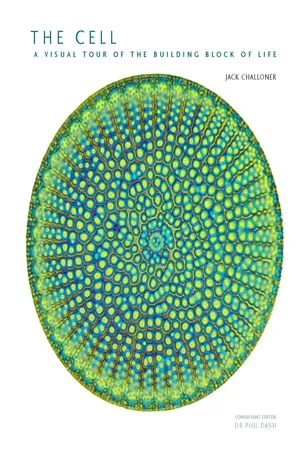Biological Sciences
Cell Division
Cell division is the process by which a parent cell divides into two or more daughter cells. It is essential for growth, repair, and reproduction in living organisms. The two main types of cell division are mitosis, which produces two identical daughter cells, and meiosis, which produces four genetically diverse daughter cells.
Written by Perlego with AI-assistance
Related key terms
2 Key excerpts on "Cell Division"
- eBook - ePub
The Cell
A Visual Tour of the Building Block of Life
- Jack Challoner, Dr Philip Dash(Authors)
- 2015(Publication Date)
- Ivy Press(Publisher)
CHAPTER THREECells Beget CellsHere is a big thought. Every single single-celled living thing, and every single cell in every multicellular living thing, was created from an existing cell that split in two. The process of Cell Division is clearly important—and, by looking at the details, it becomes apparent that Cell Division explains far more than just how new cells are made.Re: CycleFalse color transmission electron micrograph of Staphylococcus aureus bacteria, most of which are in the act of dividing in two. Cell Division is the way in which all single-celled organisms reproduce, and the way in which multicellular organisms grow.The incredible goings-on inside cells—the manufacture of proteins, the production of energy, the constant shuffling of motor proteins along microtubule tracks—would achieve nothing if cells did not have a way of reproducing by dividing in two. Eukaryotic cells divide in two via a chain of events called the cell cycle.Grow, duplicate, split, repeatCell Division is how single-celled organisms reproduce. Multicellular organisms grow and develop by repeated Cell Division, although some can also use Cell Division to reproduce (see here ). In order to divide successfully, a cell must ensure it contains enough vital material to make two cells, including making a copy of its genome (all of its DNA), and divide everything up equally. Once the cell has divided, the whole process begins again in each of the two “daughter” cells. In single-celled prokaryotic cells, Cell Division is simple and quick (see here ). The process takes much longer in eukaryotic cells because their genomes are typically hundreds or thousands of times the size of those in prokaryotic cells. What’s more, they have many membrane-bound organelles and a cytoskeleton to copy. In eukaryotes, Cell Division is achieved via a coordinated, repeating process called the cell cycle.VEGETATIVE REPRODUCTIONSome eukaryotic organisms make entirely new individuals by Cell Division. In plants, this is called vegetative reproduction. Bulbs and tubers, which provide a way of storing food for hard times, also provide the potential for a new plant. Stolons, or runners, are another way in which some plants produce offspring. They are stems that extend horizontally at ground level and have nodes from which a new plant can grow. - eBook - ePub
Cellular Signal Processing
An Introduction to the Molecular Mechanisms of Signal Transduction
- Friedrich Marks, Ursula Klingmüller, Karin Müller-Decker(Authors)
- 2017(Publication Date)
- Garland Science(Publisher)
Regulation of Cell Division 12Cell proliferation is mandatory for reproduction and for development, repair, and maintenance of tissues. In fact, the apparatus of Cell Division is an ultimate target of most of the signal-processing reactions explained in the previous chapters. In the following, we shall have a closer look at pathways that connect this apparatus with the cell’s signal-processing network. The investigation of these interactions has tremendous practical consequences because defective transduction of signals controlling cell proliferation is a major cause of cancer.12.1 The cell cycleProliferating cells pass through a sequence of phases presented as a cyclic process. This cell cycle is conserved in all eukaryotes. It provides a perfect example of how a highly complex cellular event is controlled temporally and spatially by signaling reactions that are tightly interlinked and feedback-controlled to ensure that the genetic material has been correctly copied and evenly distributed to the daughter cells. Pioneering work on cell cycle regulation was honored by the Nobel Prize in Physiology or Medicine for 2001, awarded to Leland H. Hartwell, R. Timothy Hunt, and Paul M. Nurse.The production of intact and genetically identical daughter cells presupposes a precise sequence of the cycle phases. For instance, separation of chromosomes must not occur before complete chromosome condensation, which requires DNA replication to be finished to proceed correctly. Therefore, the cell cycle is interrupted at least three times by checkpoints (Figure 12.1 ) that give the data-processing network an opportunity to monitor the precision of DNA replication and chromosome segregation and, if necessary, to launch repair measures or, in the case of irreparable damage, to promote cell death (for details see Section 12.8
Learn about this page
Index pages curate the most relevant extracts from our library of academic textbooks. They’ve been created using an in-house natural language model (NLM), each adding context and meaning to key research topics.

